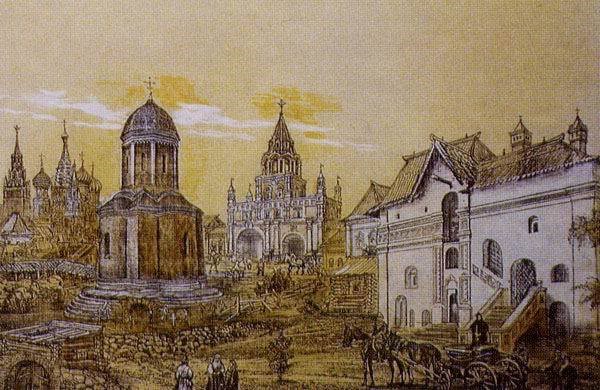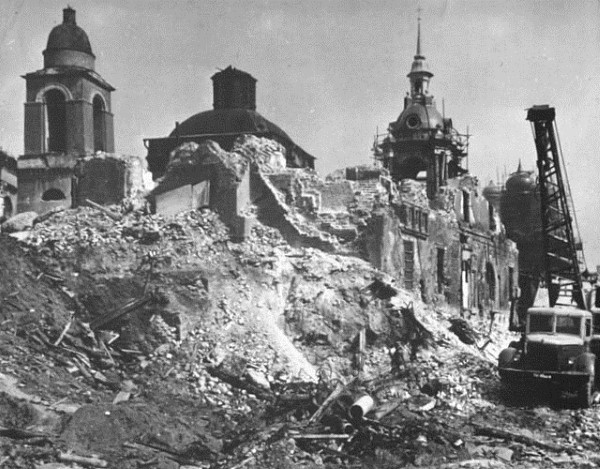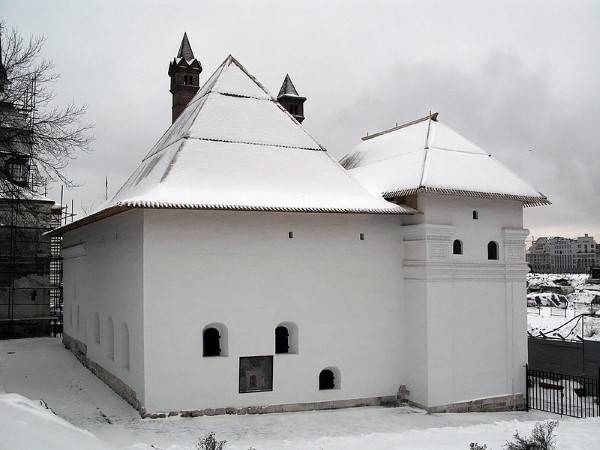The Old English Court—a unique monument of Russian civil architecture from late 15th century to mid-16th century—has reopened on Varvarka Street in Moscow after a long restoration.
The court originally belonged to Ivan Bobrishchev, also known as Yushka, who was gentleman of the bedchamber to Ivan III. It stands to reason that one of the neighboring side streets carried his name until mid-20th century. The building was then reconstructed and escheated.
Old English Court / V. Ryabov. Panoramic view of Zaryadye, late 17th century
In 1556, following the arrival of Englishman Richard Chancellor, who survived a shipwreck and discovered the Northeast Passage in the process, Ivan the Terrible bestowed the right of free trade on the “English Germans” and gave them “the Yushkov court in Moscow, near Saint Maximus.” The Cathedral of Maximus the Confessor has also survived to this day.
The Muscovy Company was established in London a year before that. The court in Zaryadye became the company’s Moscow ‘office,’ effectively making it the first representative office of a foreign business in Moscow. The English had a lot to offer: they purchased hemp, ropes, wax, leather and fur in Russia and brought weapons, gunpowder, broadcloth, tinware and other goods to the Russian market.
The building was quite typical for its time, with thick, fortress-like walls, luxurious apartments and vast storage rooms. Goods were delivered to the window of the warehouse using a wheel-and-axle machine. According to the archives, the English “Embassy” had a lot of stuff to hide, as it received a quarter of a bull, four sheep, a dozen chickens, two geese with a rabbit or a grouse, sixty-two loaves of bread, fifty eggs, a quarter of a bucket of Mediterranean wine, a bucket of beer, half a bucket of vodka and two buckets of honey every day—quite a meal!
Early 1960s, before the demolition
The building had many different owners later, some of them distinguished, some not so much (it should be noted that it was at the Old English Court where Peter the Great opened one of the first Schools of Arithmetic in Moscow), all of whom kept rebuilding and rearranging it to their liking. As a result, the 20th century saw the structure that was built at the same time as the Kremlin’s Palace of Facets turn into a faceless four-storied revenue house that would be demolished according to the reconstruction plan—the plan providing for destroying Zaryadye completely.
If not for famous restoration artist Pyotr Baranovsky who was remarkably observant despite his old age, the building would be demolished. Legend has it that he approached the “renovators,” shouting in a most exuberant manner, “Don’t touch it: It’s 17th century!” In the late 1960s, the historical foundation of the building was exposed, and the Old English Court was restored in 1970–1972 in accordance with its late 17th-century plans.
Modern view
In October 1994, the opening ceremony at the English Court Museum was attended by Queen Elizabeth II and Philip, Duke of Edinburgh, who were on a visit to Russia at the time. Opening the museum after a restoration period in the bilateral year of Russia and the United Kingdom also seems quite symbolic, the Old English Court being the only place in Moscow where the era of Shakespeare meets the age of Ivan the Terrible.
The museum’s display has been expanded through authentic ancient items found in Zaryadye during excavation works, as well as multimedia components. The management of the Moscow Museum curating the building believes that the Old English Court presents ample opportunities for various museum programs ranging from traditional concerts of early music to costume events, interactive projects, master classes and so on. Meanwhile, the building itself, with the Rossiya Hotel no longer in the background, will look completely different in the historical landscape of Moscow’s central area.










